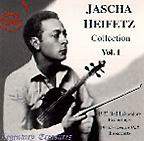DOREMI's Jacob Harnoy Resurrects Classic Performances by Wah Keung Chan
/ June 1, 1998
Version française...
Sound engineer Jacob Harnoy is the director of the
DOREMI mastering studio and record label in suburban Toronto.
Presently, Harnoy is one of the world's foremost experts on
restoring old acoustic recordings - mostly lacquer 78s - to pristine
condition on CD. His DOREMI digital audio laboratory specializes in
restoring the recorded legacies of great classical musicians such as
violinists Jascha Heifetz, David Oistrakh and Nathan Milstein,
guitarist Andres Segovia, cellist Vladimir Orloff, pianist
Sviatoslav Richter and violist William Primrose.
Harnoy was trained as a violinist and also studied
mathematics, physics and chemistry. He taught at the University of
Toronto before becoming a research scientist with Ontario Hydro, yet
music always remained the love of his life. In the 1970s and 1980s
he produced and engineered his daughter Canadian cellist Ofra
Harnoy's many recordings for RCA Red Seal. To date, he has produced
nearly 250 recordings for RCA and Analekta, among other labels.
Harnoy, now in his fifties, retired from Ontario Hydro two years ago
to start DOREMI, his own label specializing in audio
restoration.
Harnoy's interest in audio restoration dates from
the mid-1980s, when he got fed up with the poor quality of
commercially available CD transfers of his favourite old 78 and LP
recordings. "The CD transfers actually sounded worse than the
original recordings. There was too much surface noise, making them
difficult to listen to. I knew that I could do a better job."
Harnoy devoted a year to developing digital
restoration components and to experimenting with noise reduction
software such as CEDAR and Sonic Solution's No-Noise, during which
time he and his technician Harry Quan designed a custom
analog-to-digital converter.
The actual restoration of an old recording is a
time-consuming business. Harnoy has no qualms about spending 200-400
hours perfecting a single CD, because for him, sound restoration is
a labour of love, "Most companies budget a maximum amount per CD for
restoration. They couldn't afford the time I take."
The usual audio restoration process at DOREMI
follows four steps:
-
Conversion from the analog sound source into the
digital domain.
-
Noise reduction with the CEDAR System
-
Noise reduction with the No-Noise process (when
necessary)
-
Digital equalization and
bit-conditioning.
Of course, good sources and the right needle for
the 78s are of primary importance. An avid collector since age 10,
Harnoy has amassed a huge collection of old records. He also taps a
network of fellow collectors for source material, and is helped by
DOREMI's own researchers.
Once the material is transferred to digital, Harnoy
uses the computerized CEDAR noise reduction system to reduce hiss,
crackle, small clicks and pops. He checks the results with a "before
and after", A/B comparison to ensure all of the original sonority is
preserved. Analog-to-digital conversion and CEDAR noise reduction
are done in real time, i.e., the results are stored as the record is
played. The No-Noise process, on the other hand, requires many hours
of intense computing. At one of DOREMI's Macintosh workstations,
Harnoy demonstrates the Sonic Solutions' No-Noise processor. The
process is akin to touching up a scratchy photograph. Each big click
is removed by the No-Noise interpolation technique.
Harnoy played me a "before and after" demo CD of
Granados' Dance No. 5 by guitarist Andres Segovia. The
results were spectacular, with the instrument sounding remarkably
close and clear. Harnoy emphasizes that the recording technology
back in the 1930s and 1940s, including microphones, was "more
advanced than we tend to think today." Harnoy is often surprised by
the richness of the original sound after the surface noise has been
removed. "The great violinists had a personal, distinctive character
and sonority. I'm trying to bring it back."
When asked where he stood on the issue of keeping
the absolute "authenticity" of an interpretation versus "improving"
it, he replied firmly, "As I would do to new recordings that I
produce, if I can fix a wrong note, I will. It's not the musician's
fault if their engineer left an error there. My aim is to display
the musician's artistry at its best."
Standing among piles of old records in his studio,
Harnoy reflects, "there are many great neglected artists out there
that I would like to restore." We can look forward to many treasures
to come.
 Some
Doremi Titles: Heifetz Series: Jascha Heifetz Collection Vol. 1 (DHR
7705) of 1932 Bell Laboratories test recordings and 1943-45 radio
broadcasts (contain material never before available -in any form -
commercially). (Segovia and His Contemporaries: Andres Segovia &
Julio M. Oyanguren CD Vol. 1 (DHR 7703) - first of the three now
available in the Segovia series, was voted by classical retailers
attending Allegro's 1997 annual conference as the "Best Historic
Classical CD of the Year". David Oistrakh Collection: Vols 1-4. For
future releases consult the DOREMI website: http://www.doremi.com/~doremi/ Some
Doremi Titles: Heifetz Series: Jascha Heifetz Collection Vol. 1 (DHR
7705) of 1932 Bell Laboratories test recordings and 1943-45 radio
broadcasts (contain material never before available -in any form -
commercially). (Segovia and His Contemporaries: Andres Segovia &
Julio M. Oyanguren CD Vol. 1 (DHR 7703) - first of the three now
available in the Segovia series, was voted by classical retailers
attending Allegro's 1997 annual conference as the "Best Historic
Classical CD of the Year". David Oistrakh Collection: Vols 1-4. For
future releases consult the DOREMI website: http://www.doremi.com/~doremi/
Version française... | 

